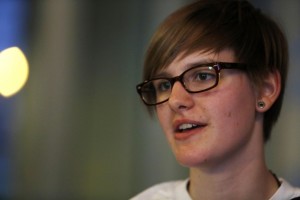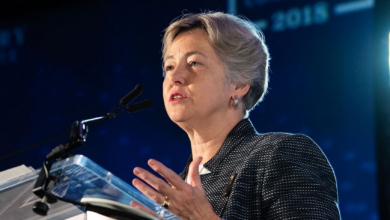Preferred pronouns gain traction at US colleges
By Lisa Leff
Associated Press

Photo: Mathew Sumner/AP
OAKLAND, Calif. — The weekly meetings of Mouthing Off!, a group for students at Mills College in Oakland, Calif., who identify as gay, lesbian, bisexual or transgender, always start the same way. Members take turns going around the room saying their names and the personal pronouns they want others to use when referring to them — she, he or something else.
It’s an exercise that might seem superfluous given that Mills, a small and leafy liberal arts school historically referred to as the Vassar of the West, only admits women as undergraduates. Yet increasingly, the “shes” and “hers” that dominate the introductions are keeping third-person company with “they,” “ze” and other neutral alternatives meant to convey a more generous notion of gender.
“Because I go to an all-women’s college, a lot of people are like, ‘If you don’t identify as a woman, how did you get in?'” said sophomore Skylar Crownover, 19, who is president of Mouthing Off! and prefers to be mentioned as a singular they, but also answers to he. “I just tell them the application asks you to mark your sex and I did. It didn’t ask me for my gender.”
On high school and college campuses and in certain political and social media circles, the growing visibility of a small, but semantically committed cadre of young people who, like Crownover, self-identify as “genderqueer” — neither male nor female but an androgynous hybrid or rejection of both—is challenging anew the limits of Western comprehension and the English language.
Though still in search of mainstream acceptance, students and staff members who describe themselves in terms such as agender, bigender, third gender or gender-fluid are requesting—and sometimes finding—linguistic recognition.
Inviting students to state their preferred gender pronouns, known as PGPs for short, and encouraging classmates to use unfamiliar ones such as “ze,” “sie,” “e,” “ou” and “ve” has become an accepted back-to-school practice for professors, dorm advisers, club sponsors, workshop leaders and health care providers at several schools.
The phenomenon gained notice in the San Francisco Bay area in early November after an 18-year-old student at a private high school in Berkeley suffered severe burns when a 16-year-old boy set fire to the student’s skirt while the two were riding a public bus. The parents of the injured student, Sascha Fleischman, said their son is biologically male but identifies as agender and favors they as a pronoun.
At the University of Vermont, students who elect to change their names and/or pronouns on class rosters now can choose from she, he and ze, as well as the option of being referred to by only their names. Hampshire College in Massachusetts advertises its inclusiveness by listing the gender pronouns of its tour guides on the school’s web site. And intake forms at the University of California, Berkeley’s student health center include spaces for male, female or other.
At Mills, the changes have included tweaking some long-standing traditions. New students are now called “first-years” instead of “freshwomen.” The student government also has edited the college’s historic chant —”Strong women! Proud women! All women! Mills women!” to “Strong, Proud, All, Mills!”
The nods to novel pronouns and nonconformity are an outgrowth of campaigns for gender-neutral bathrooms and housing that were aimed at making campuses more welcoming for transgender students moving from one side of the gender spectrum to the other. But as fewer young people choose to undergo sex reassignment surgery, such students are slowly being outnumbered by peers who refuse to be limited, said Genny Beemyn, director of the Stonewall Center at the University of Massachusetts, Amherst.
“Certainly we see students who are transitioning, particularly female to male, but the vast majority of students who identify under the trans umbrella identify in some way outside the binary, and that’s really causing a shift on college campuses,” said Beemyn, who studies gender identity in higher education and recently traded ze for they. “Having role models and examples allows people to say ‘Yes, what I am feeling is legitimate.'”
As neologisms like “ze” have moved beyond conversation and into students’ academic papers, some professors have expressed annoyance and uncertainty about how to respond, said Lucy Ferriss, writer-in-residence at Trinity College in Connecticut and a frequent contributor to the Chronicle of Higher Education’s language blog, Lingua Franca. .
“There is an initial discomfort. I think it’s probably hypocritical to pretend there isn’t, to say, ‘Ok, that’s what they want to do’ and leave it at that,” Ferriss said. “The people I know who teach will say ‘This is weird and it’s cumbersome and it’s not going to last because it’s not organic.'”
At the same time, Ferris thinks it’s a mistake for scholars and grammarians to dismiss the trend without considering whether English and society might be served by less-rigid ideas about gender.
“Mail carrier did not evolve organically and it’s a lot easier to say mailman. Decades ago there were poets who refused to be called poetesses,” she said. “Most language has evolved organically, but there have been times—and when it comes to issues of gender there probably have to be times—when there are people willing to push the envelope.”
Mel Goodwin, youth program director at the gay and lesbian community center in Las Vegas, said getting the hang of alternative pronouns can be tricky in conversation. Goodwin, 28, claimed they as a preferred pronoun four years ago and it took time “to unlearn what I had been taught about gender.”
Yet when people object to they as being grammatically incorrect, Goodwin counters that modern English is to blame and that scholars, writers and linguists have spent more than a century trying to come up with gender-neutral pronouns that stick. In public presentations, Goodwin also refers to a map that shows historic and contemporary cultures around the world that have recognized more than two genders.
“This is not about young people in the U.S. over the last 20 years kind of coming out of the woodwork and making up labels that aren’t real,” Goodwin said. “This is a real variation among humans, period.”










